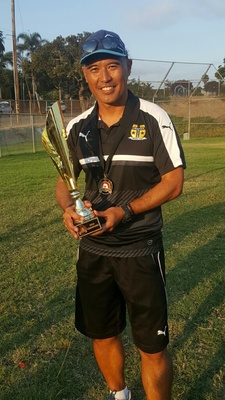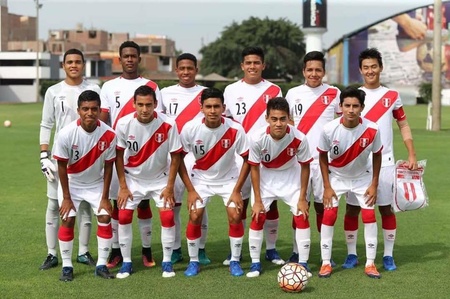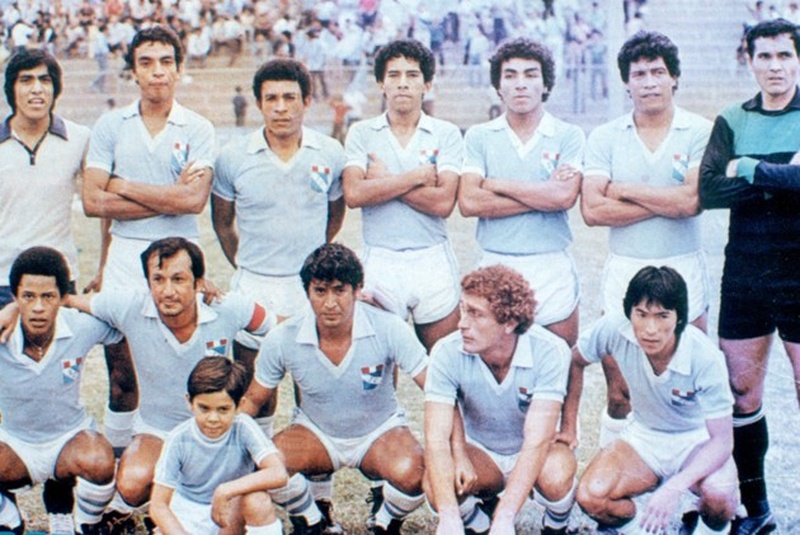Nikkei names delighted Peruvian soccer fans from the 1950s to the 1980s, and in subsequent decades this wave of enthusiasm expanded to other countries. And just like with the Iwasaki brothers, there was yet another story of Nikkei brothers. There was no shortage of Asian names among the 16 teams in the national league, which was known as the "decentralized league" because it resulted from the consolidation of the regional and metropolitan leagues.
When "Coki" Hirano moved to Japan to play soccer in 1980, he was joined by forward Emilio Murakami. Two years later, they met on the field again wearing the light blue jersey of Peru’s Sporting Cristal, with whom they won the championship in 1983 along with 26-year-old veteran player Pedrito Ruiz, already a veteran, who continued to play into his 40s. In the years that followed, this club would once again cheer on soccer players of Japanese descent.
This was the era when Deportivo AELU bade farewell to the first division after three years in the top professional league. However, many of its Nikkei players went on to other clubs in Peru and abroad with varying levels of success. Héctor Takayama Tohara, for example, played for several teams before traveling to Japan, where he played for Tosu Futures in 1995 and then for FC Jazz in Finland. Other standouts in first division also continued their careers far from Peru.
Sports nostalgia

The 1990s were dark years for both soccer and Peru because of terrorism, but every era brings with it some great memories. During those years, Jerry Tamashiro was one of the leading players in the Peruvian national league, first with Universitario de Deportes and later Deportivo Municipal and Alianza Lima. In 1998 he began playing in the United States with MLS team Miami Fusion alongside Colombian idol Carlos "El Pibe" Valderrama and other Latin American players.
Without a doubt, Tamashiro’s future was in the United States. He began training as a coach and for the past 12 years has been working with youth teams for America, Conquist America and Real Laguna, winning championships in California and at the regional level1. Currently, Jerry is also a scout for the U.S. soccer team. “The popularity of youth soccer among both boys and girls is surpassing baseball and American football,” he says.

Other Nikkei, such as Leonardo Uehara La Serna (a cousin of the Uehara Kaneku brothers), also had outstanding careers during that decade. Known as "El Charapa," not only did he play with La Loretana, the team in his region, but also for Universitario de Deportes and FBC Melgar de Arequipa, among others, and was part of the 1997 America Cup team. Others from those years include the Soria brothers and José Pereda Maruyama, all of whom played for the national team.
The Nikkei of Cristal
Several players of Asian descent also played for the Rímac team, as Sporting Cristal is known. These include Roberto Salazar Shimabukuro (born in Lima in 1973), who came up through the AELU, where he was the leading scorer in the second division. The team went on to play in the Copa Libertadores. In 2000, brothers Javier and David Soria Yoshinari joined the same club.
Javier's left kick, which debuted in Deportivo AELU, took him to the first division in 1998, with Alianza Atlético de Sullana. His performance led to a contract with Sporting Cristal in 2000, the year he joined his brother David. David began his career in Japan with Consadole Sapporo and played for Sporting for six years, winning the championship with them in 2000 and 2005.
Javier played in the 1999 America Cup along with José "Chino" Pereda (where oddly enough they played against Japan, which had been invited to participate), while David played in pre-Olympic Game matches and the qualifying round for the 2002 Japan-Korea World Cup. On the Peruvian team, Pereda was often a starter in the midfield, and then received the call to join Atlético Boca Juniors in Argentina, where he won six championships.
"Chino" the champion

Considered the most successful Nikkei soccer player ever, José Pereda was born in the district of Breña, home to Universitario de Deportes club. He started there at age 12 and was on the first team in 1992 and 1993; that team won the championship both years, although Pereda didn't play in those matches. With few opportunities to play, he decided to join the Lawn Tennis soccer club and later Cienciano del Cusco, where his outstanding performance enabled him to return to "la U" in 1996.
In 1998, Universitario de Deportes was once again the national champion, with Pereda among the regular starters. In a surprising twist, that same year he was recruited by Boca Juniors, a traditional Argentine team that had not won the first division title since 1992. With "El Chino" they won three national championships from 1998 to 2000, as well as the Libertadores Cup and an Intercontinental Cup in Japan, against the powerful Real Madrid.
Although Pereda wasn't among the regular starters for Boca during those four years, he was a member of one of the best Argentine soccer teams of all time, playing in 36 games (starting 25 of those). With Peru's national team, he played in two World Cup qualifying games and an America Cup, scoring four goals for his country. In 2002, he returned to "la U" to continue his winning streak, in the opening tournament of that year. He retired in 2009 and now coaches youth soccer.
The "Samurai" of the blue and white
While in the 1990s Universitario de Deportes and Sporting Cristal dominated the Peruvian league with four and five championships, respectively, in the 2000s Alianza Lima was the top club, winning four championships. During those years, one defender for Deportivo Municipal had a remarkable run with the blue and white team, for which he played for nine years: Ernesto Arakaki Arakaki, who was formed by the AELU but is most closely identified with the club from La Victoria district.
He was part of the under-20 team but played his most outstanding games with Alianza Lima, for which he also scored several goals. He was a member of teams that won four championships in that decade (2001, 2003, 2004 and 2006) and played in several international tournaments (Libertadores, Merconorte and Sudamericana). He retired from soccer in 2010 at just 30 years old due to an injury, but in 2013 he returned to Alianza Lima to work with the youth team.
After studying to become a coach, founding an academy and completing a master's degree in sports management, "the Samurai," as he was called during his years as a player, joined Esther Grande de Bentín and was later assistant coach for the under-17 team. He now manages the Alianza Lima youth divisions. “In Peru it's difficult to find people who want to be coaches, unlike in other countries where they can start training children as young as eight years old”, he said2.
New names, new challenges
In the last decade, new Nikkei names have emerged onto the field of play for different teams in Peru, particularly in the provinces. Juan Carlos Nakaya, César Goya, Manuel Ugaz Nemotto and Christian Laura Senaga are just a few of them. One special case is that of Mario Kazuma Tajima, a Nikkei born in Colombia but whose father is Peruvian. He began his career with Esther Grande de Bentín and later reached the minor divisions of Universitario de Deportes.
Born in Bogotá in 1993, Tajima's nickname is "Goku." He plays in the midfield and in 2012 was part of the team that won the under-20 Libertadores Cup held in Peru. The same generation includes Oshiro Takeuchi Bambarén, who made his debut with Alianza Lima and later played for Juan Aurich and León de Huánuco. Recently, new Nikkei powerhouses in the minor divisions have emerged to join club youth teams, and are expected to establish themselves and move on to even greater challenges.
Pedro Ynamine Kitano (born 1998) has been a defender for Sport Boys in second division and Universidad de San Martín de Porres. On the latter team, the goalkeeper played with Hideyoshi Arakaki Chinen, a forward of the same age, and who was also his teammate on the national under-15 and under-17 teams. Arakaki was part of the team that won the under-15 South American championship in 20133, scoring three goals (two against Argentina and one against Chile in the semifinals).
The current captain of the under-15 team is Anthony Aoki Nakama (born 2000), who has played for AELU and Sporting Cristal. The winger starts for Esther Grande de Bentín along with Mauricio Matzuda Gusukuda. They're both seeking an opportunity to compete in the first division and make a name for themselves among the growing list of Nikkei whose histories continue to unfold behind the ball.

Notes:
1. Jerry Tamashiro
2. “El cambio generacional debe hacerse de a pocos” [VIDEO] (Spanish)
3. El camino hacia el título: así fue la campaña del Perú campeón Sub 15 (Spanish)
© 2017 Javier García Wong-Kit






